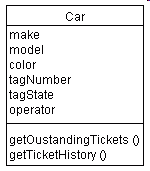

|
An Introduction to Object Oriented Programming
|
|
Prof. David Bernstein
|
| Computer Science Department |
| bernstdh@jmu.edu |



|
An Introduction to Object Oriented Programming
|
|
Prof. David Bernstein
|
| Computer Science Department |
| bernstdh@jmu.edu |















Weight Class:
Weight class to someone
they could use it improperly (e.g., assign negative values
to ounces or pounds; assign 16 or greater to ounces)





